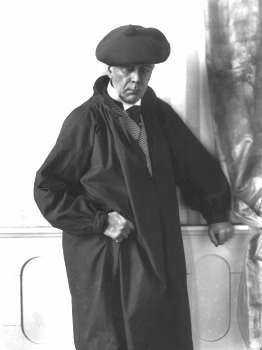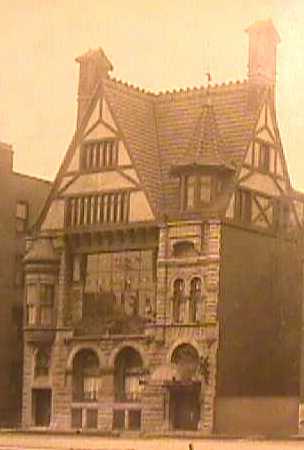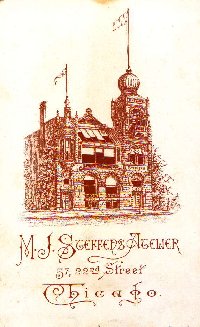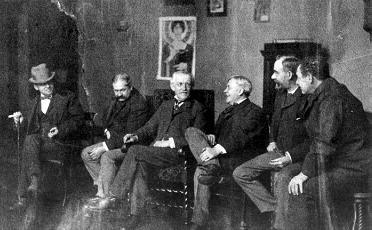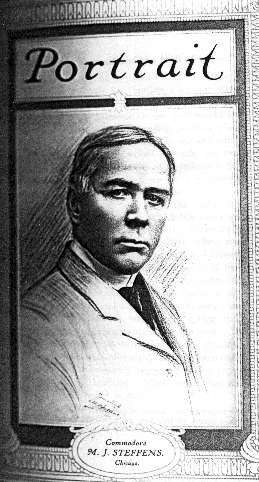MATHEW
J.
STEFFENS
THE COMMODORE
(1854-1928)
COPYRIGHT
BY THOMAS G YANUL
Among
those photographers who flourished in the last third of the19th century
were
outstanding talents like M.J. Steffens. An immigrant who took advantage of
America's burgeoning commercial & industrial wealth. Steffens was an
astute businessman, photographer and artisan who by 1872 had established
himself on the near s.e.side of Chicago, an area just beginning to attract
the very well-to-do of Chicago. It became known as the first "Gold Coast",
attracting the wealthiest of the wealthy. The Palmers, Fields, Kimbal, Glessner
and numerous others would all build mansions to proclaim their economic
successes.
Steffens
got in on the ground floor so-to-speak, as the neighborhood would continue
its growth of the upper classes into the 1890's.
BACKGROUND
- WHAT IS KNOWN
[according
to published reports]
Steffens
was born at Hontheim, Germany June 10, 1852, the son of Jacob and Christine
(Thullen) Steffens. Educated in the high schools of Hamburg & Altona,
Germany. He emigrated to America as a young orphan, arriving in Chicago
in 1867 or earlier, according to the only published account of Steffens'
early days.
[ThePhoto-Beacon
Magazine, Apr.1894, edited by F. Dundas
Todd]
The
Photo-Beacon account went on to say:
"as a young orphan, he came to Chicago alone, while still a mere boy. His
first, and indeed only employer, was George Pullman of Pullman Car
fame, for whom he painted the fancy work on the cars, an occupation which
probably had something to do with laying the foundation for the artistic
taste that has been a considerable factor in his successful career. Any kind
of work well done rarely fails to bring its own reward, and by and by he
was transferred to the Pullman shops at Detroit, although not more than sixteen
years of age.
"About
this time his attention was attracted to photography, and he grew more
and
more anxious to acquire an acquantance with its practice, but the few
who
could
teach it wanted such large fees, and required him to work without pay so
long as to be altogether out of his reach. But belonging to that class that
has faith in itself and believing that difficulties were only made to be
overcome, he bought a small wet collodion outfit and several guide books,
and started in determined to conquer, if it were possible, and conquer he
did, although it took many months of persevering work before he could make
a decent negative.
"Just
about the time that a fair degree of success had crowned his efforts, accounts
of Chicago's great fire reached Detroit, and he hurried back to see perhaps
the greatest fire on record, reaching the doomed city on the third day of
the blaze, and, as if there had been something inspiring in the vitality
which enabled it, phoenix-like, to rise from its ashes, he shortly
thereafter opened a small gallery on 22nd street. Here he must have
done well, as in 1878 he studied for nearly a year in the Academy in Rome,
then visited the principal European cities, especially those of France and
Italy, returning to Chicago with a vastly increased knowledge of art and
new ideas of the possibilities of
photography.(The American Academy was not yet opened in Rome -1894-
so which "Academy" he attended is as yet unknown)
"His
old studio, no longer up to his requirements, was sold, and one more in
accordance with his ambition erected in the same street; and there he has
remained one of the most prosperous in this or any other country, each year
apparently better that its predecessors.
"Mr.
Steffens is a quiet, unassuming gentleman, devoted to his profession, but
fond of a little relaxation in his steam yacht - his favorite pastime is
marine photography - on the beautiful Lake Michigan, within almost a stone's
throw of which his establishment is situated.
STEFFENS
FAMILY
In 1871 Mathew married Swiss-born Rosette
Fischer .
They
had three children: Laura (1877-1942), Leo A.(1878-1952) and Romeo Joseph
(1881-1941) later known as Richard.
Laura
married architect Louis Christian Mullgardt in 1897, divorced
1929.
Leo
Steffens
took over his father's business when he retired.
Richard
Joseph Steffens - ( also took up photography but his
career
was centered in Vancouver, B.C. beginning in 1920. At the time of his death
he operated as the Steffens-Colmer studio(s).
His
wife at the time of death was Alice Blakensee Steffens.
NOTE:
NEW
INFORMATION HAS COME TO LIGHT THAT RICHARD WAS MARRIED TWICE:
HAD A SON, RICHARD JOSEPH JR. (1904-1971) BY HIS FIRST WIFE,
MINNA SAWYER.
RICHARD,
WHO WAS ACTUALLY NAMED ROMEO AT BIRTH (SWISS NAME), FIRST
MARRIED MINNA SAWYER, A RESIDENT OF LANCASTER, NEW HAMPSHIRE, ON
OCTOBER 7,1902. RICHARD, ACCORDING TO INFORMATION FROM BROTHER
LEO STEFFENS, WAS A SALESMAN FOR THE EASTMAN KODAK CO.
AND THATS HOW HE MET MISS SAWYER IN NEW HAMPSHIRE.
A
SON, RICHARD JOSEPH STEFFENS JR. (1904-1971) CAME OF THAT UNION.
RICHARD AND MINNA WERE DIVORCED SOMETIME BEFORE 1916 - THE YEAR THAT
MINNA REMARRIED. THERE APPARENTLY WAS NO CONTACT BETWEEN
FATHER AND SON AFTER THE DIVORCE. JOSEPH JR.'S DAUGHTER IS ALIVE
AND WELL AT THIS WRITING. HER NAME IS MRS PATRICIA STEFFENS
CLARK.
My
thanks to Patricia Steffens Clark, greatgranddaughter of Mathew J.
Steffens
NOTE:
Laura Steffens' husband, Louis Christian Mullgardt, (1866-1942) had a
rather
auspicious architectural career that began in St.Louis, then Chicago, and
culminated in California. His work at the Panama-Pacific International Exposition
of 1915 and residential designs have been documented by noted architectural
historian Robert Judson Clark.
IN
GENERAL
What
little there is comes from published articles and notes, mostly found in
photo journals and magazines of the day. Commodore Steffens was cited because
of his activities within the professional photographic business
community.
He
was often a speaker on technical issues; lighting, chemistry, posing, etc.
at local & national photographic association meetings &
conventions.
By
all accounts he was a forceful, dedicated photographer whose door was always
open to visitors. He was an apparent jovial gentleman with a flair for
hospitality and congeniality. These same attributes applied to several of
the more successful portrait photographers that were his peers and friends
such as Strauss of St. Louis and Frank Scott Clark of Detroit. Steffens'
title of "Commodore" was bestowed as a former president of a yacht club.He
belonged to several such clubs.
M.J.
Steffens seems to have gone into semi-retirement sometime around the beginning
of WWI, and by 1917 he has moved to a nearby fashionable hotel (the Lexington,
616 Michigan av.) while his son Leo took over the day to day work of the
studio. But the neighborhood of the rich and famous of the day was deteriorating
by the first world war; the rich having abandoned the south side in favor
of a new Gold Coast on the near northeast side. Soon the old studio was given
up on 22nd St., and Leo moves the operation to the Fine Arts Building
Annex,located in the business district of downtown Chicago on south Michigan
av. Leo operates the studio for another decade or so but his business clientele
is
much
different than his fathers, more to the "standard trade" of businessmen,
politicians and middle and working class families. M.J. died April 30,
1928.
Steffens'
self-confidence and intelligence obviously served him well. To have placed
himself in such a socially demanding position as photographer to the very
rich took not only professional and technical skill, but social skills to
operate sucessfully in that rarified atmosphere. And judging by the
notoriety he achieved in his profession, he also had the artistic and technical
skills to impress his peers.
Steffens
was the first of the "Big Six" portrait photographers that I knew about,
long before I every heard of the Big Six. I began researching Steffens
some 15 years ago after acquiring some of his personal portfolios that were
in the home of a family whose husband had been the official photographer
at the Chicago Columbian Expo of 1893. I took carloads full of paperwork
out of
the
Gibson house on E. Cullerton St. A home that Mrs. John J. Gibson had
lived in since 1919 ( a widow since 1902) and a stone's throw from Commodore
Steffens' old studio. For years Mrs. Gibson had rented on the block adjacent
to Steffens' old studio while he was still active there. She had been in
Chicago since 1893 helping her husband at the Exposition, and later at their
large studio in downtown Chicago, its no doubt she was familiar if not indeed
good friends with the Commodore. How or why the materials ended up with
Mrs.Gibson is unknown. Part of the material gathered at the Gibson house
were two large folders of Steffens photographs and some glass negatives,
personal and business.
Some
of the original portrait prints are stunning, while others provided clues
to his professional/personal connections such as Frank Scott Clark of
Detroit and Gustav Cramer of St. Louis.
It
has literally taken years to gather just the basics about Steffens. And of
course the internet has all but made it possible. HIs son Richard was nowhere
to be found for 15 years. He was not buried with other members of the Steffens
family, which by the way turned out to be in a cemetery only 10 minutes from
my house, and my search took me literally all over the land chasing leads
on people named Steffens. Only months ago did I uncover a lead on the
internet
which was graciously confirmed by a fine Canadian (BC) archivist. His research
fleshed out the bare essentials on Richard Steffens' photographic career
in Canada. Now all the Steffens children have been accounted for, and only
Richard's (Romeo) side has continued to this day. Richard Died 1-23-41 Leo
(three wives) had no children. Died 12-15-52, Battle Creek, Michigan.
Daughter
Laura,a talented harp musician, married St. Louis architect Louis Christian
Mullgardt. They had four children but the family line no longer has direct
descendandts. The Mullgardt line continues from Louis's brothers.
.
NOTE: Steffens' studio address - 1882-86. Chicago city
directories show him at:
2246-49
Cottage Grove Av. - a stone's throw from his later 22nd St. location. These
are listings only for advertisers. Its quite possible Steffens was simply
not listed in the earlier commercial sections.
AUTHOR'S
NOTE:
THE
FAMILY PLOT IN MT. GREENWOOD CEMETERY ON CHICAGO'S SOUTH WEST SIDE BEARS
NO
STONE
OF ANY KIND. A LARGE GROUP OF PLOTS WAS BOUGHT AT THE TIME OF MATHEW'S DEATH
IN 1928, ALONG WITH A SPACE FOR A FAMILY STONE. SOMEHOW
SON LEO MANAGED TO PUT
HIMSELF,
HIS THREE WIVES, 1ST WIFE'S FATHER , ALONG WITH MATHEW AND WIFE IN THE
GROUND, BUT MUST HAVE RUN OUT FUNDS TO MARK THE RESTING PLACE
OF HIS FAMILY. THE GRAVES
REMAIN
WITHOUT IDENTIFICATION. ONLY A WEEDY, GRASSY PLOT ATTESTS TO THEIR PRESENCE-
THE
LOCATION RECORDED ON A YELLOWED 4X6" CEMETERY FILECARD.
